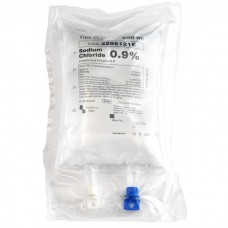SODIUM CHLORIDE 0.9% - NORMAL SALINE 500ML IV FREEFLEX BAG (K690521)
- Brand: Fresenius Kabi
- Product Code: K690521
-
Ex GST: AU$5.40
General Information
In medicine, saline (also saline solution) is a general phrase referring to a sterile solution of sodium chloride (NaCl, more commonly known as table salt) in water, but is only sterile when it is to be placed parenterally (such as intravenously); otherwise, a saline solution is a salt water solution. The sterile solution is typically used for intravenous infusion, rinsing contact lenses, nasal irrigation, and cleaning a new piercing. Saline solutions are available in various formulations for different purposes. Salines are also used in cell biology, molecular biology, and biochemistry experiments.
Normal saline (NS or N/S) is the commonly used phrase for a solution of 0.90% w/v of NaCl, about 300 mOsm/L or 9.0 g per liter. Less commonly, this solution is referred to as physiological saline or isotonic saline, neither of which is technically accurate. Normal saline was invented by Dutch physiologist Hartog Hamburger in 1896. It is used frequently in intravenous drips (IVs) for patients who cannot take fluids orally and have developed or are in danger of developing dehydration or hypovolemia. NS is also used for aseptic purpose. NS is typically the first fluid used when hypovolemia is severe enough to threaten the adequacy of blood circulation, and has long been believed to be the safest fluid to give quickly in large volumes. However, it is now known that rapid infusion of NS can cause metabolic acidosis.
Usage
For medical purposes, saline is often used to flush wounds and skin abrasions. Normal saline will not burn or sting when applied.
Saline is also used in I.V. therapy, intravenously supplying extra water to rehydrate patients or supplying the daily water and salt needs ("maintenance" needs) of a patient who is unable to take them by mouth. Because infusing a solution of low osmolality can cause problems, intravenous solutions with reduced saline concentrations typically have dextrose (glucose) added to maintain a safe osmolality while providing less sodium chloride. As the molecular weight (MW) of dextrose is greater, this has the same osmolality as normal saline despite having less sodium.
The amount of normal saline infused depends largely on the needs of the patient (e.g. ongoing diarrhea or heart failure).
Saline is also often used for nasal washes to relieve some of the symptoms of the common cold.
Eye drops are saline-containing drops used as an ocular route to administer.
Other concentrations commonly used include:
- Half-normal saline (0.45% NaCl), often with "D5" (5% dextrose), contains 77 mEq/L of Na and Cl and 50 g/L dextrose.
- Quarter-normal saline (0.22% NaCl) has 39 mEq/L of Na and Cl and almost always contains 5% dextrose for osmolality reasons. It can be used alone in Neonatal Intensive Care Units.
- Hypertonic saline may be used in perioperative fluid management protocols to reduce excessive intravenous fluid infusions and lessen pulmonary complications. Hypertonic saline is used in treating hyponatremia and cerebral edema Rapid correction of hyponatremia via hypertonic saline, or via any saline infusion > 40 mmol/L (Na+ having a valence of 1, 40 mmol/L = 40 mEq/L) greatly increases risk of central pontine myelinolysis (CPM), and so requires constant monitoring of patient response. Water privation combined with diuretic block does not produce as much risk of CPM as saline administration does; however, it does not correct hyponatremia as rapidly as administration of hypertonic saline does. Due to hypertonicity, administration may result in phlebitis and tissue necrosis. As such, concentrations greater than 3% NaCl should normally be administered via a central venous catheter, also known as a 'central line'. Such hypertonic saline is normally available in two strengths, the former of which is more commonly administered:
- 3% NaCl has 513 mEq/L of Na and Cl.
- 5% NaCl has 856 mEq/L of Na and Cl.
- NaCl solutions that are less commonly used are 7% (1200 mEq/L) and 23.4% (approx 4000 mEq/L), both of which are used (also via central line), often in conjunction with supplementary diuretics, in the treatment of traumatic brain injury.
- Dextrose (glucose) 4% in 0.18% saline is used sometimes for maintenance replacement.
Tags: Solutions, IV Infusion, Saline

